- Monastery's Annual Programme
- Padmasambhava Puja Calendar
Tibetan New Year
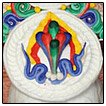
The New Year celebration/ Losar commences with the four days of ritual prayer offering and throwing Torma to destroy the evil spirits of the earth and thereby to welcome the beginning of the new days wishing full of happiness and prosperity for all the sentient beings. This festival falls in the mid or end of February of every year. It is on 22nd February of this year with the main puja being held from 19-24th February, 2012.
Saka Dawa - The Birth, Enlightenment and Parinirvana of Buddha
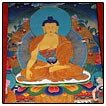
It falls in the fourth month of the Tibetan calendar; the monastery conducts 16 days of meditation programme in the name of Chenrezig or Avalokiteswara. During these days many dharma devotees come from various places to practise this holy programme. It corresponds to June 4, 2012 in the Gregorian calendar.
During the meditation period following rules are to be followed: Alternate meals, no dinner, no conversation, no combing, non possession of ornaments, no drinking of water, no bathing, etc. In the meditation hall the preaching is done on "love and compassion" by a regular practitioner H.E the Dhardo Rinpoche wherein he tries to arouse the humanitarian feelings of the devotees and to commit themselves for the betterment of sentient beings.
Tukpa Tse She Anniversary of Buddha's first teaching is celebrated on every June 6th of Tibetan calendar and will be on 21st July, 2012.
H.H. The Dalai Lama's birth anniversary

It falls on 6th July. The monastery celebrates and performs one day holy programme for his long and prosperous life.
Lhabhab Dhuchen

Anniversary of Buddha descending from Tushita heaven. The monastery holds three days of special grand fire puja especially to purify the earth and to welcome Buddha and also to show the path for those passed souls. It is on 6th November, 2012.
Ganden Ngamchol

Death anniversary of Je-Tsongkhapa, the founder of Gelukpa sect, is a great poet and a philosopher of Tibet who has given many teachings in Buddhism in Tibet. On this day the monastery offers earthen lamps and prays in his memory. Tsongkhapa's birthday will be observed on 8th December, 2012.
January 4th

Guru Rinpoche receives rabjung ordination from Buddha's favourite disciple, Ananda. He shows unparalleled understanding and mastery of both sutra and mantra, and is known as Guru Shakya Senge [Lion of the Sakyas].
February 2nd
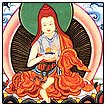
The king of Zahor tries to burn Guru Rinpoche alive. But he transforms the fire into Lake Rewalsar and establishes Dharma in the land of Zahor, taking Mandarava as his consort. He is know as Guru Chimè Pemajugnè [Immortal Lotus-born].
March 3rd

Guru Rinpoche is worshipped as Padma Vajra Chhal.
April 2nd
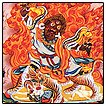
When Tirthikas [disputing philosophers] from South India attempt to harm the Buddha Dharma, Guru Rinpoche with his great power vanquishes them along with their gods and guardians. Raising the Victory Banner of the Dharma, he is known as Guru Sengé Dradok- the Lion's Roar.
May 31st
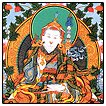
Birth of Guru Rinpoche, Guru Rinpoche Day: At sunrise Guru Rinpoche is miraculously born amidst dazzling radiance in a lotus bed on Lake Danakosha. Turning the Wheel of Dharma for the dakinis, he is know as Guru Tsokyé Dorje - Guru, the Lotus-Born Vajra.
June 30th
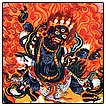
The Tirthikas from Tamradvipa throw Guru Rinpoche into the Ganges. Rising from the water, he reverses the flow of the river and performs a Vajra Dance in the sky. The Tirthikas are inspired with devotion, and begin to follow the Dharma. Guru Rinpoche is known as Guru Khading Tsal - Guru, soaring in the sky like the garuda.
July 29th
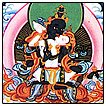
Guru Nyima Woser meaning the rays of the sun.
August 27th

Guru Rinpoche takes the form of Vajrakumara at Yang Leshö in Nepal, and subdues the local deities and negative forces. He performs the sadhana of Palchen Yangdak and atttains the Vidyadhara stage of Mahamudra realization. He is know as Guru Dorje Tötreng- Vajra Guru, Garland of Skulls.
September 26th
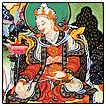
Guru Rinpoche arrives in central Tibet. He subdues all the hostile negative forces, founds the great monastery of Chö-Khor Pal-gyi Samyé and lights the lamp of the Holy Dharma of the Sutra and Mantra teachings. Guiding his twenty-five disciples and the king to liberation, he is known as Padmasambhava, the Lotus-Born Guru.
October 25th
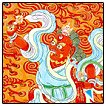
In order to preserve the practice of Dharma in Tibet, and secure the commitment of the local spirits to extend their protection across generations, Guru Padmasambhava emanated as Guru Dorje Drolo. In this form, he reconfirmed the power of his realization and ensured the support and submission of the invisible beings.
November 24th
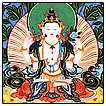
Guru Padma Gyalpo is the form in which Guru Padmasambhava originally appeared in our world. He is directly related to Buddha Amitabha, the Buddha of the western direction, as well as to Avalokiteswara, the Buddha of compassion.
December 22nd

Guru Rinpoche renounces his kingdom, practices yoga and meditation in the great charnel ground of Sitavana, and attains liberation. Gathering under him the matrikas and dakinis, he is known as Guru Shantarakshita: Guardian of Peace



